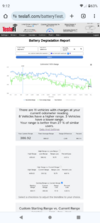For the new car, never above 85, or below 22%. Store at 50% or lower. Per SMT, down from 99.4 KwH new to 91ish NFPafter only 18 months and 10k miles.
As degradation is rather predictable, I would guess that if the time above 55% is limited and you so not live on a very hot place, the calendar aging the first year would be around 3%, and 18 months would set you at about 3.7%, so lets say 4% then.
Your new S should have about 95kWh capacity.
I guess your BMS was not given the opportunity to see the battery capacity.
A few full charges, if you anyway are to drive a bit, and a few occasions with single number SOC might be good for the BMS calc. (I have not performed any BMS calibs myself, Im not worried about the degradation rate at low SOC).
So I would say that it is a steong possibility that the BMS is wrong.
Do you do any longer trips?
Mooking at the charging and resulting difference in SOC, or the re-estimation after a longer drive could tell quite much sbout the real capacity, without even doing a BMS calibration.

[Edit]I forgot: The different failure modes.
No we do not know anything about these.
Probably the battery manufacturing process produce cells with more even quality today than before.
And probably tesla did learn a lot about do’s and don’ts.
I guess the failure rate will be lower but newly introduced failure modes we can not protect us from in the most cases.
Water intrusion or broken BMB’s or contactor can happen to anybody.
Having less degradation before the failure should ensure I get a replacement battery with the same degradation or less.
I can not see a reason not to take care of the battery.
The main reason for me to write as much about batteries as I do is that I see a loth of myths or misinformation about lithium batteries. The mainstream has been more wrong than wright.
From all research about lithium batteries its not hard to draw the conclusion that as most chemistries behave similar and in modt cases the same chemistry behave very similar, and this had been going on for more than 10 years, the batteries will continue to behsve about the same. Solid Electrolyte Interphase will continue to grow, lithium plating will still happen etc.
Things will change slowly except for new inventions like Solid state batteries etc.
So it will be very safe to say that our Palladium batteries will have very similar degradation behaviour as the Panasonic NCA tested acfewcyears back. We can hope that the rate for SEI build up has been slightly reduced, and that the cells are less sensitive to lithium plating etc. But it is not wise to expect the things that are based on how the chemistry work will suddenly disappear.
One example is the LFP introduction into 3/Y. From my perspective it was clear that these batteries did not like 100% more than our Panasonic NCA in the model S/Y does.
One could never be 100% sure about it, but at least 97% sure that these batteries would degrade about the same as the LR/P Chemistries, and that the absolute main part would come from calendar aging.
This proved right, they mainly follow the expected degradation rate (from calendar aging).



